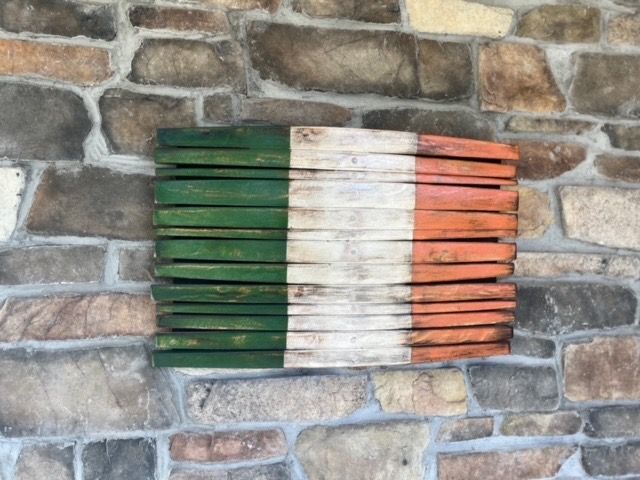[caption id="attachment_71260" align="aligncenter" width="600" caption="The Titanic under construction at Harland and Wolff. "]
The story of the Titanic has been told and retold for decades now. The unsinkable ship built in Belfast sank on its maiden voyage in 1912 with the loss of 1514 lives.
Recently, as I walked through Sainsbury's supermarket on the Falls Road a special exhibition of cardboard and papier-mâché Titanics made by local school children from St. Aidan's on the Whiterock Road were on show.
They were all shapes and sizes. Some of them were three feet long. One had an iceberg and a sinking Titanic beside it.
The loss of the Titanic has been the storyline for several movies. One of the most successful ever, simply entitled "Titanic," has been re-released in 3D to mark the centenary of the tragedy and will probably make another staggering profit for its makers.
I remember the black and white "A Night To Remember" movie made in 1958. In recent days, there was a drama series on one of the British television networks dealing with the sinking. It was also shown on an American network.
Over the years, the fate of the Titanic has featured in a host of other dramas, from the 1960s TV show "Time Tunnel" to a recent episode of Dr. Who.
What is it that has so captivated the imagination and hearts of countless millions around the world? Is it the irony of the unsinkable ship that sank, the countless stories of loss and tragedy among its 1514 victims, or the heroism of the band that kept playing to the end?
The survival accounts of those who lived through that ordeal make for compelling reading. Also compelling is the story of the 14 Irish emigrants, men and women, sailing to a new life in the USA from Addergoole, in County Mayo.
Like millions of others, they were fleeing poverty and the political turmoil of an Ireland still in the grip of British colonialism, this in the hope of a better live in America.
The 14 were aged between 17 and 42. They joined the Titanic in what was then Queenstown, now Cobh, in County Cork. Four days later, 11 were dead. The Western People described the impact on Addergoole thus: "When the first news of the appalling catastrophe reached their friends the whole community was plunged into unutterable grief."
But it was also far from easy for the three survivors. The youngest, Annie McGowan, had to spend months in hospital recovering from her experience. When she was discharged she had only a nightgown and a coat. A U.S. newspaper recorded how Annie and her friend Annie Kate Kelly, who was 20. were "given an old pair of shoes but they were forced to make the trip from New York to Chicago in their coats and night gowns. They had no dresses nor underwear."
Their story is not exceptional. The facts behind the Titanic are generally well known. It was one of three Olympic class ships built by Belfast shipbuilders Harland and Wolff for the White Star line.
It was the biggest liner of its day and weighed in at a massive 46,000 tons. It was 882 feet and 9 inches long and at its widest it was 92 feet and 6 inches.
It ploughed into an iceberg just before midnight on April 14th and sank approximately two and a half hours later. 710 passengers survived although there was room for around 400 more on the lifeboats, many of which were launched only half-full.
It is also widely known that class played its part in determining who lived and who died. Three percent of first class passengers died. 54 percent of third class died. Five out of six first class children died and all second class children survived. 52 out of 79 children in third class perished.
But there is another part of the Titanic story which is rarely told and must not be ignored. Belfast's two shipyards, Harland and Wolff and Workman, Clarke and Co. were notoriously sectarian employers.
The numbers of Catholics employed by the firms was tiny and in the course of the 19th century, and early twentieth century, Catholic workers were frequently expelled from the yards, often beaten, while some were killed.
The story of the shipyards is the story of division, sectarianism and exploitation in Belfast. In 1800, Belfast had a population of some 20,000 citizens. 60 years later, it had increased tenfold and by the end of the century the population had reached 350,000.
The number of Catholics living in the city also increased from 4,000 in 1800 to around a third of the population in 1900. Living and working conditions were appalling. Overcrowding in slum housing with no sanitation was the norm for working people. Hours were long and child labor was prevalent.
Conditions for women in the linen mills were notoriously difficult and dangerous. However, a structured system of discrimination, encouraged by an alliance of the unionist political elite, the Orange Order, and employers, meant that all of the well paid, skilled work and trades were predominantly Protestant, especially in shipbuilding and engineering.
Dividing workers was to the advantage of the owners as it prevented the development of effective labor organizations arguing for better wages and conditions for workers.
Playing on these sectarian divisions also ensured that political unionism was able to retain the loyalty of working class Protestants with whom they otherwise had little in common.
It is no accident that the worst years of riots and violence in Belfast, including expulsions of Catholics from the shipyards and other engineering factories, coincide with the introduction of the three Home Rule Bills for Ireland - 1886, 1893 and 1912 - and the Government of Ireland Act in 1920.
In July 1912, up to 8,000 catholic workers were expelled from the shipyards and other factories in the city and eight years later the pattern was repeated with up to 10,000 Catholic men expelled from the shipyards and four major engineering works, with 1,000 women from the linen mills.
One British labor leader summed it up well the same year Titanic was launched when he said: "In Belfast you get labor conditions the like of which you get in no other town, no other city of equal commercial prosperity from John O'Groats to Land's End, or from the Atlantic to the North Sea. It is maintained by an exceedingly simple device. Whenever there is an attempt to root out sweating in Belfast the Orange big drum is beaten......"
In 1911, as the Titanic was being built, the census recorded that there were 6809 shipbuilders in Belfast. Of these, 518, or 7.6 percent, were Catholic. This is a part of the legacy of the British presence in Ireland, and of the divisions it fostered. The roots of decades of conflict are to be found in that history, and experience.
Today, as a result of the peace process, there is a unique power sharing system of government in the north of Ireland. As it seeks to build a better future for citizens and create employment it is investing in the regeneration of the old shipyards and in a new Titanic Belfast Exhibition Centre which is the biggest Titanic-themed tourist attraction in the world.
It is hoped it will bring in hundreds of thousands of tourists and help create much needed employment. But as we celebrate this potential for the future, we must also remember the type of society that built the Titanic, commit to learning the lessons of that time, and ensure that those divisions and hardships are relegated to the history










